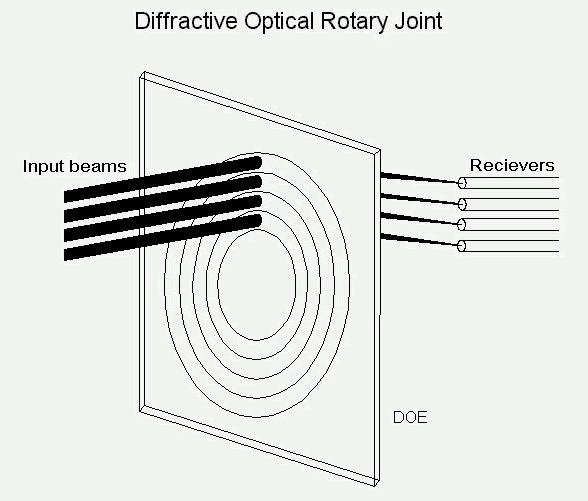Circle-to-point conversion and Optical rotary joints
Doppler shifts in the optical spectrum may be detected either by heterodyne methods using coherent sources or by direct detection of filtered and dispersed return light. The coherent method requires diffraction limited optical trains and a local oscillator. The direct detection method is far more relaxed , requiring only "photon bucket" collection optics and a series of blocking filters and etalons to separate the frequency shifted light into a radial pattern. The direct detection of a Fabray-Perot pattern can best be done with a PMT or microchannel plate that has been constructed to have many equal area electrically isolated detection rings. Such a detector placed at the image plane can handle large fields of view and is good at preserving precious photons. A less expensive alternative would be a device that could effectively transform the output of the etalons into a string of foci spaced correctly to fit into a line of fibers or onto a linear CCD or photo diode array. This device could be called a circle-to-point converter and simply redirects all the rays that enter each of the circular annuluses into unique off axis focal points. One way to do this is to cut out annular sections of the edges of lenses and piece them together with appropriate offsets in their respective focal positions. An extension of this method would be to cut up plastic Fresnel lenses or diffractive lenses. These devices can also be thought of as fractured zone plates, re-assembled for the purpose of separating and detecting the Doppler shift imparted to a narrow frequency laser pulse by winds or moving objects. The increments in frequency occur in equal area annuluses so the coarse appearance of such an optic is that of a zone plate as well. The main purpose for this optical element is the remote detection of regional wind speeds.
The same peculiar optical element constitutes a kind of rotary optical joint, useful in coupling wideband signals from a spinning platform to a stationary platform. In this alternative application the device is best made with each annulus being the same width rather than the same area. That would make it appear to be a coarse axicon rather than a coarse zone plate. Otherwise, they are or can be the very same optical element. Each annulus is simply an off axis focusing DOE or HOE that gets shifted laterally by some arbitrary increment between zones. We would change the way they are masked if shooting them in a step and repeat fashion and nothing else. Figure 1 shows a likely layout of the circle to point pattern and figure 2 is the corresponding rotary joint pattern. The circle to point pattern is used with full illumination over the aperture which has been made to have as many as 24 annular regions in a 25 mm diameter. The rotary joint would be used with individual modulated lasers or fibers addressing each zone with only a pencil beam. The number of channels would be limited by the size of the beams and the allowable crosstalk. The focus is shifted conveniently off the axis of rotation and out of the path of any zero order light in both applications.
The method of fabrication and replication can be the same for each device. We made units with 24 zones as computer generated binary patterns recorded directly in photopolymer. They could also have been patterned into photo-resist and dry etched into silica. We opted to add a high frequency carrier to eliminate the possibility of cross talk from higher orders, alternatively a correct blaze could have been used at lower frequencies so that the parts could easily be fabricated by mechanical replication. We also made the same functional units by starting with a holographically constructed master which was subsequently stepped between exposures along with a mask of 7 or 24 rings. The HOE constructed this way can then be copied optically in one step into another volume recording material for higher volume production.
Acknowledgements
The diffractive design and fabrication of the rotary joints were carried out independently by Mathias Johansen and Sverker Hard at the Chalmers University of Technology in Sweden and the design of the circle to point converter was contributed by Matt McGill and others at Goddard Space Flight Center with fabrication being done at Ralcon development lab. Patents have been filed for or granted to both parties and both are deserving but I can't help being amused by the entirely coincidental invention of the same complex diffractive optical element for two widely differentiated applications. It makes me wonder how often such things occur. More details about each of these optical elements and the applications the were designed for can be found in the references and from the authors. Optical Interconnects is another field where similar devices may be used and could be searched for. It would not be a surprise to find the same device in the literature of that field and possibly also in holographic memories.
References
- Matthew J. McGill, M. Marzouk, V. S. Scott, J. D. Spinhirne <Holographic circle- to-point converter with a particular application for Lidar work> Opt. Eng. Vol 36 pp 2171-2175 Aug 1997.
- Mathias Johansson, Sverker Hard <Design, fabrication, and evaluation of a multichannel diffractive optic rotary joint>, App Opt, vol 38, no. 8, pp 1302-1310, 10 Mar 1999.
- R. D Rallison <Fractured zone plates for spatial separation of frequencies> SPIE vol 3633, pp 92-102, Diffractive and Holographic Elements, San Jose, CA, Jan 1999
Last modified on 5/12/00

